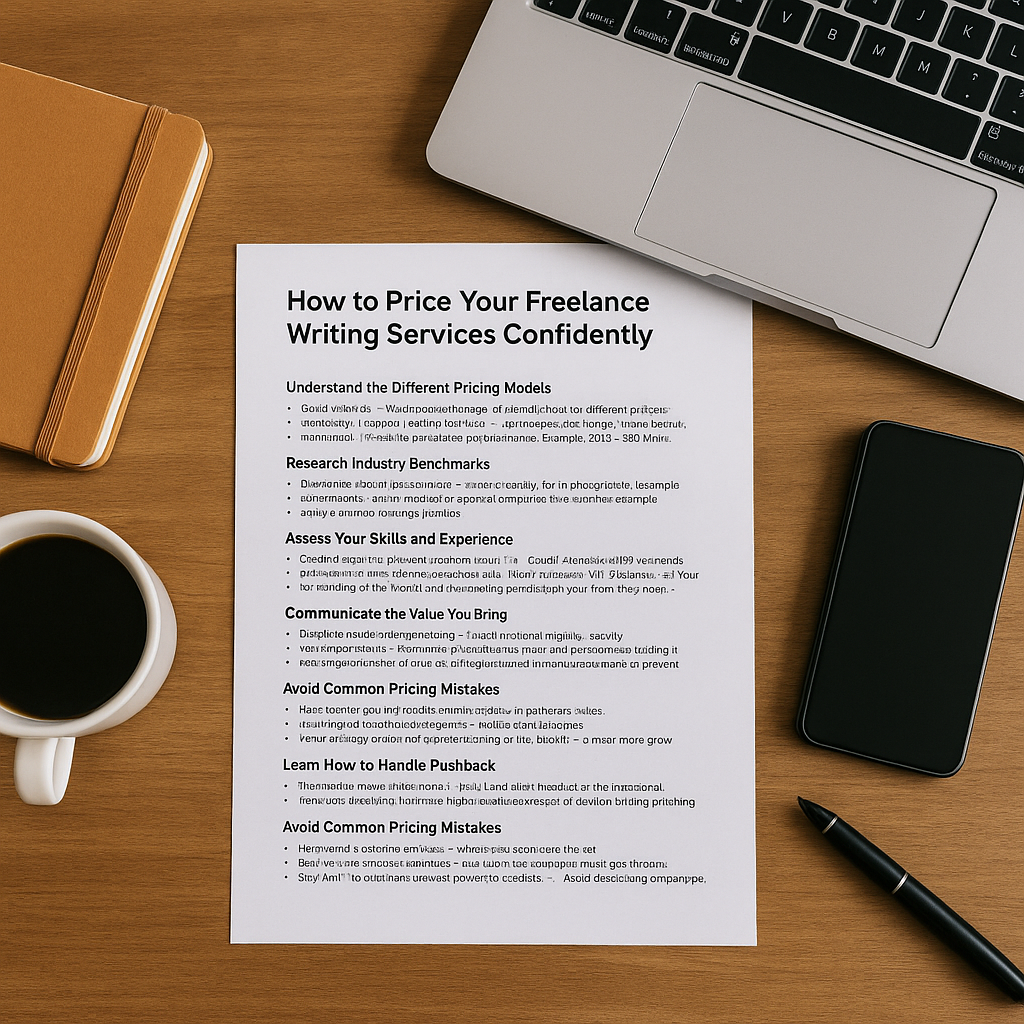One of the biggest struggles for freelance writers — especially when they’re just starting out — is knowing how to price their services. Set your rates too low, and you risk burnout and underpayment. Set them too high, and you fear scaring away potential clients.
The good news? With the right strategy, you can price your writing confidently, fairly, and profitably. In this article, we’ll break down how to set your rates, communicate your value, and avoid common pricing mistakes.
Understand the Different Pricing Models
Freelance writers typically use one of the following pricing methods:
- Per word → Common in journalism, blogging, or SEO writing. Example: $0.10–$1.00 per word.
- Per hour → Good for ongoing projects or editing work. Example: $25–$100/hour depending on experience.
- Per project → Ideal for larger deliverables like white papers, case studies, or website copy.
- Monthly retainer → Great for long-term clients. Example: $1,000/month for four blog posts.
There’s no one-size-fits-all — the best pricing model depends on the client, project, and your personal preference.
Research Industry Benchmarks
Before you set your rates, research what others in your niche are charging. Check:
- Freelance writing surveys → Look at annual reports like the Freelance Writer’s Survey or Contently’s rate report.
- Freelance groups → Ask for feedback in Facebook or Slack communities.
- Job boards → Review postings on sites like ProBlogger or Upwork to understand typical budgets.
Keep in mind: rates vary widely by niche, experience, region, and client size.
Assess Your Skills and Experience
Be honest about your current level:
- Beginner (0–1 year) → Expect to start on the lower end.
- Intermediate (1–3 years) → You can confidently charge mid-level rates.
- Experienced (3+ years) → You can command top-tier rates, especially in a niche.
Also consider specialized skills, like SEO knowledge, UX writing, or marketing strategy — these allow you to charge premium rates.
Calculate Your Minimum Acceptable Rate
Before quoting prices, calculate how much you need to make.
- Add up your monthly expenses (rent, bills, taxes, health insurance).
- Decide how many hours or projects you want to work.
- Factor in business costs (software, subscriptions, marketing).
- Set an income goal that covers your needs and allows room for growth.
Example: If you need $3,000/month and can take on 12 articles, you need to earn $250/article just to meet your goal.
Communicate the Value You Bring
Clients don’t just pay for words — they pay for results.
Highlight how your writing:
- Attracts customers or readers
- Boosts SEO rankings
- Strengthens their brand voice
- Saves them time and headaches
The clearer you are about your value, the easier it is to justify premium rates.
Create Tiered Pricing Packages
Offering package options can help clients choose the best fit without haggling.
For example:
- Basic Blog Post ($150) → 500 words, one round of revisions
- Standard Blog Post ($250) → 1,000 words, SEO optimization, two revisions
- Premium Blog Post ($400) → 1,500 words, SEO, images, social media captions
This gives clients flexibility — and shows that higher rates come with added value.
Avoid Common Pricing Mistakes
New freelancers often fall into these traps:
- Underpricing to get clients → You’ll end up overworked and underpaid.
- Not raising rates over time → As you gain experience, your rates should increase.
- Quoting without full details → Always clarify scope, deadlines, and revision limits.
- Not using contracts → A clear contract protects you and the client.
Start confidently and avoid discounting your worth.
Learn How to Handle Pushback
Not every client will say yes to your rates — and that’s okay.
When facing objections:
- Emphasize the results they’re getting, not just the cost.
- Offer a smaller package or reduced scope if needed.
- Stay firm — don’t slash your rates just to “win” the client.
Remember, some clients will walk away — and they’re often the ones you’re better off without.
Keep Reviewing and Raising Your Rates
Set a regular schedule (for example, every six months) to review:
- Are you hitting your income goals?
- Are you consistently overbooked?
- Has your skill level improved?
- Are you delivering more value?
If the answer is yes, it’s time to raise your rates.
Final Words: Confidence Comes With Clarity
Pricing freelance writing services doesn’t have to feel like a guessing game.
When you know your value, research your niche, and communicate clearly with clients, you can set rates that reflect your worth — and grow a business that’s both profitable and sustainable.
Start where you are, improve as you go, and remember: confident pricing is one of the most powerful tools you have as a freelance writer.
